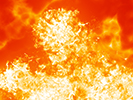 |
 |
|
|
In the face of the Lord. Gor Chahal often works intuitively, convinced of the necessity of something that has not yet realised its meaning. Comprehension usually comes afterward upon completion of the work. It can be said that the final end reveals the meaning of the whole duration of existence. By making everything complete the end highlights the significance of an individual’s life and its historical role. Death turns life into a biography, retroactively regulates it, gives it new coverage, and sometimes even a moral meaning. The theme of retrocausality is significant to the Christian worldview Iliotropion by St. John of Tobolsk teaches us to co-ordinate the human will with the divine on the same basis; "Try to do what you must, and understanding will come at the end of the life path, when you meet the Creator". The exhibition project develops on a series of experiments on the polyphonic union of the traditional liturgical language and that of contemporary art A spatial image of a person walking to the face of the Lord is created by a long piece of paper rolled across a gallery floor at the Mdina Cathedral Museum towards the St. Paul retable, the gold powder markings show traces of people walking upon it towards the St. Paul retable. These footprints are hardly perceptible at the beginning yet seem to merged into the golden ground at the end of the path. The movement flows forward from a blank sheet towards the gold-filled surface. It dawns on the viewer that this movement is not plausible in reality. Technically, everything happens the other way around. Dipping his feet into a golden powder, the artist moved backwards from the gold end of the path towards the blank end, leaving footprints with traces of powder on the paper until the gold powder ran out. The viewer feels the movement ofthe tracks in reverse, the visual image of retrocasuality. Thus, «two arrows of time» have been created. The arrow of action directed to the future, and the arrow of understanding directed to the past. |
